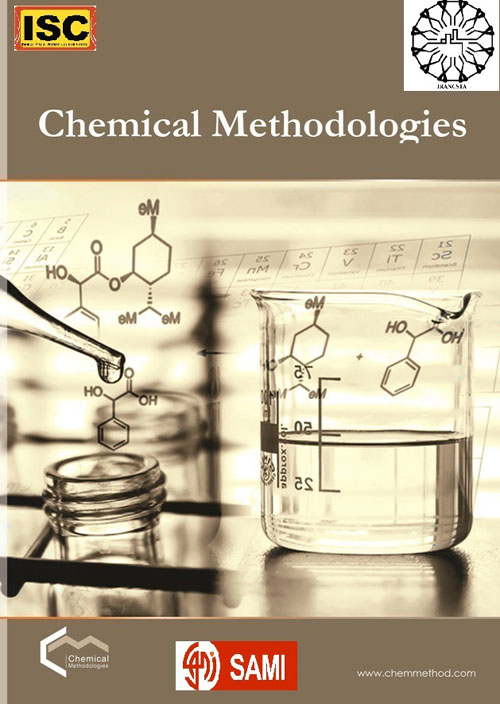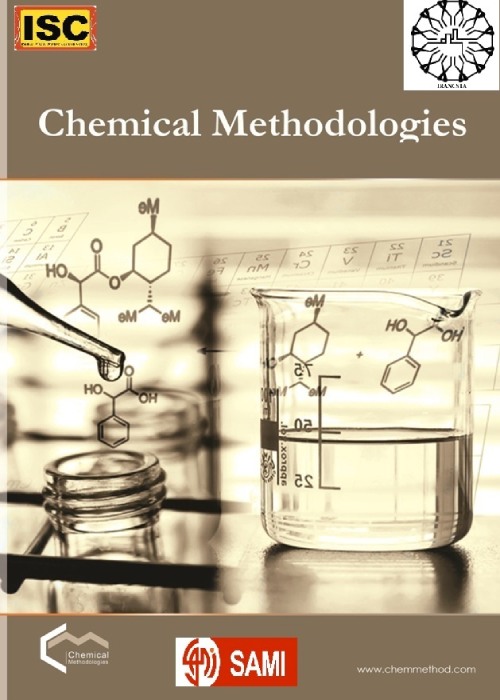فهرست مطالب

Chemical Methodologies
Volume:6 Issue: 11, Nov 2022
- تاریخ انتشار: 1401/06/10
- تعداد عناوین: 8
-
-
Pages 813-822
New substituted coumarins derivatives were synthesized by using nitration reaction to produce different nitro coumarin isomers which were separated from these isomers by using different solvent, and the reduction of nitro compounds was done to give corresponding amino coumarins. Temperature and reaction time of reaction were very important factors in determining the most productive nitro isotopes. A low temperature for three hours was sufficient to give a high product of a compound 6- nitro coumarin while increasing the temperature for a period of twenty-four hours that gave a high product of 8-nitro-coumarin. The synthesized compounds were confirmed by FT-IR, 1H-NMR, and 13C-NMR spectroscopy and all final compounds were tested for their antifungal and antibacterial activity. Some of them showed more biological activity than the standard drugs. Some synthesized compounds showed a variation in their antioxidant activities according to IC50 values. Some of these compounds had a very good antioxidant compared with ascorbic acid as a standard.
Keywords: Coumarin, Nitration, reduction, aminocoumarin, Antioxidant -
Pages 823-830Carbon quantum dot light is produced by the UV-lit nanoparticles (NPs), and LEDs are explained. They created the nanoparticles. The Poisson equation was used to forecast surface state levels that surface nanostructure would cause to emerge in the optical energy spectrum of CQDs. The chromaticity of the produced light coordinates and the wavelength of the associated color was determined by using the photoluminescence (PL) spectrum. A study of the X-ray diffraction (XRD) was carried out to determine the type of material and size.Keywords: Carbon quantum dots (CQDs), UV, LEDs, XRD
-
Pages 831-841In this paper, ZnO/TiO2/cement nanocomposites were fabricated by a simple casting method with different concentrations of ZnO (0, 0.4, 0.6, and 0.8 wt.%) and of TiO2 (0.8, 0.4, 0.2, and 0 wt.%). The aim of this study was to understand the effect of dye concentration (5 and 10 ppm) on the photo-catalytic activity of TiO2/ZnO/cement nanocomposite. The samples of the synthesized nanocomposites were characterized by the scanning electron microscopy (SEM) technique. The observed photocatalytic efficiency of the nanocomposites was investigated by decomposing the dye methylene blue in an aqueous solution under sunlight irradiation. (FE-SEM) image of the TiO2/cement nanocomposite with 0.8 wt.% content was examined. It is clear that the TiO2 nanoparticles were well attached to cement particles and they covered the cement surface the ZnO photocatalytic activity is apparently better than that of TiO2 because ZnO exhibits greater electron mobility. According to the slope, the value of the k constant = 0.0721 min-1 for ZnO/TiO2/cement nanocomposites (0.8 wt.%) at MB solution with 5ppm concentration. The contact angle of TiO2/cement (0.8 wt.%) was 27.11 because the cement is hydrophilic surface. However, the contact angle increased when ZnO added to TiO2/cement.Keywords: ZnO TiO2 nanoparticles Photo, catalytic Cement Self, Cleaning
-
Pages 842-850Quantum dots (QDs) can be defined as nanoparticles (NPs) in which the movement of charge carriers is restricted in all directions. CdTe QDs are one of the most important semiconducting crystals among other various types where it has a direct energy gap of about 1.53 eV. The aim of this study is to exaine the optical and structural properties of the 3MPA capped CdTe QDs. The preparation method was based on the work of Ncapayi et al. for preparing 3MPA CdTe QDs, and hen, the same way was treated as by Ahmed et al. via hydrothermal method by using an autoclave at the same temperature but at a different reaction time. The direct optical energy gap of CdTe QDs is between 2.29 eV and 2.50 eV. The FTIR results confirmed the covalent bonding between the 3 MPA ligands and the QDs surface. The XRD results revealed that the synthesized QDs have two crystal structures, wurtzite and cubic zinc blend. FESEM results confirmed that the NPs have a spherical shape with an average diameter of nearly 33.85 nm. TEM analysis confirmed the particle's near sphericity, with an average diameter of around 49.33 nm. The sudden increase in temperature led to increase the particle size. It was found that ligand addition, maintaining the solution's acidity, and autoclaving the material enhanced quantum confinement.Keywords: Refluxing method, Quantum dots, Aqueous method, Quantum Confinement
-
Pages 851-860This study dealt with a simple, sensitive, and rapid spectrophotometric method to determine methyldopa (MDP) in bure form and it is pharmaceutical preparation (tablet) by using a new prepared organic reagent. The method is based on preparation a new organic reagent (Schiff's base) and using it in oxidative coupling reaction with MDP in acidic medium in the presence of potassium periodate to produce a stable, water-soluble orang complex with the maximum absorption signal at 481 nm, Beer's law is followed for standard MDP solutions in the range of 5.0-40 µg/mL with a negative deviation at concentrations higher than 40 µg/mL. The molar absorptivity and Sandell᾽s sensitivity index values are 6.082×103 L.mol-1.cm-1 and 0.0347µg /cm2 with relative standard deviation of RSD% less than 5%, detection 1 limit of 0.8937 μg.ml-1 and correlation coefficient of 0.9979. Two approaches were applied to determine the MDP amount in its pharmaceutical formulation (tablets), the first depending on regression equation and the second on the standard addition method. The results were obtained with sufficient precision and accuracy, with characterization of the prepared organic reagents and the product of oxidative coupling reaction by FT-IR-spectroscopy.Keywords: Spectrophotometric Determination, Methyldopa, Oxidative Coupling, Organic Reagent
-
Pages 861-871This paper examined interaction of Graphene with Amoxicillin antibiotic through density functional theory (DFT) and by using molecular docking method. For this, the structures of Amoxicillin and, Graphene were initially optimized with Gaussian program. Then, by using the molecular docking strategy and its grading system, we computed the arrangement of 10 structures with additional negative binding energy and a fixed state compared with other samples. Finally, for the most fixed arrangement with Graphene, molecular orbitals evaluations were conducted, and binding energy along with thermodynamic evaluated, the results indicated that the adsorption of Amoxicillin antibiotic on Graphene was an exothermic. Finally, the QTAIM calculations were performed to evaluate the type of interaction and bonds created between amoxicillin and graphene.Keywords: In Silico, Molecular docking, graphene, Amoxicillin, QTAIM
-
Pages 872-885Polymer blends from Poly Acrylonitrile/Poly Methyl Methacrylate (PAN/PMMA) with different blend ratios (80/20,75/25,70/30,65/35, and 60/40) wt% undoped and doped with various lithium (Li) salts (LiCO3, Li2SO4H2O, and LiCl) at 20 wt %. Different techniques were employed to investigate the composition and optical properties of the prepared blend samples undoped and doped with Lithium salts like FT-IR and UV-Visible spectroscopies. The optical properties analysis declared that the energy gap increased from (4.0 eV to 4.20 eV) by increasing of PMMA ratio from 20 to 40 wt %. In contrast, the energy gap reduced and shifted toward the low energy side by adding lithium salts; the minimum energy gap value was 2 eV obtained from 65 % PAN and 35 % PMMA doped with Li2CO3. The optical constants were determined and plotted as a function of wavelength in the range (of 100-1100) nm. The general results showed that the optical constants (n, εr, and εi) for undoped blends increased with the PMMA ratio from 20 to 35 wt%. In contrast, all-optical constants were grown with the addition of lithium salts.Keywords: PAN, PMMA blends, Optical properties of polymer blends, Optical constants, Solid electrolyte, Lithium Salts
-
Pages 886-904Sodium ions are one of the essential cations for various activities in the human body to control fluid levels, blood pressure, and nerve and muscle functions. Sodium-ion is a highly soluble chemical that small amounts of it can be absorbed by the body through water intake. However, consuming an excess amount of sodium ions can cause problems in the body. Therefore, it is vital to measure sodium ions in water samples. A novel and cheap potentiometric sensor was developed to measure trace amounts of sodium ions in real water samples. For the purpose, four effective components in the Nernstian response of the sensor, including 1-Hexyl-3-methyl imidazolium hexafluorophosphate as an ionic liquid, 1, 4 Diaminoanthraquinone (DAQ) as an ionophore, graphene oxide nanosheets, and paraffin oil as a binder were optimized using a response surface methodology (RSM) based on central composite design. The optimum percentages of paraffin, ionic liquid, ionophore, and graphene oxide to prepare the sensor were 13.34, 11.40, 3.21, and 2.16 %, respectively. Under the best percentage of electrode components, the potentiometric sensor showed a suitable slope of 59.2 mV decade-1 over a wide Na+ concentration range (10-6-10-2 mol L-1) with a proper detection limit of 8.97×10-7 mol L-1. The sensor can be applied to measure sodium ions in a pH range of 4 to 8. The optimized geometry of the complex formed between sodium ion and the ionophore was investigated using the density functional theory (DFT) methods.Keywords: Sodium-ion Modified sensor Graphene oxide Ionic Liquid 1, 4 Diaminoanthraquinone Experimental design


